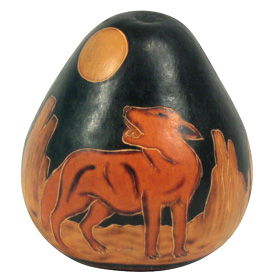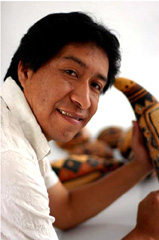
- In stock, ready to ship
- Inventory on the way
Look at the cute humming birds..how can you look at them and not say "Awww". They were hand-carved, given life, by an artisan in Huancayo, Peru. Each gourd is skinned, cleaned and sundried before its surface is etched and burnt with the intricate designs that adorn its surface. They make a Hoot of an ornament to sit on the shelf, desk, as a decoration for the home or office, or as a gift for owl lovers.
- Measures 2" high x 3" diameter at base
Gourds are a natural and uniquely shaped vegetable, similar to a pumpkin or a squash. As such, designs, shape and dimensions will vary slightly.
Handmade in Peru and Fair Trade imported
Peruvian artisans have practiced the art of gourd-carving for more than 4,500 years, transforming a simple squash into intricately designed bowls, boxes, windchimes, birdhouses, purses, vases and other bits of home decor. The twin villages of Cochas Grande and Cochas Chico, where our artisans Raquel and Esperanza live, work and run gourd-carving workshops to create local jobs, are the center of this ancient art.
Over the centuries, artisans have found unique ways to craft gourd decor, including scratching, fine-line hatching, pyroengraving and carving. Naturally, the details and designs have changed, but contemporary artisans remain inspired by Peru's rich traditions.
The Process of Gourd Carving
After the gourds are harvested, the artisan removes the outer green skin with a dull knife to expose the lighter brown color underneath. This will become his/her canvas. The gourds are cleaned and dried in the hot Peruvian sun.
 After drying, the artisan draws his/her initial design in pencil, then uses a carving tool to remove small pieces of gourd, creating a 3-dimensional version of the original design. Next, the artisan burns the pattern with a glowing ember, usually a feather-shaped piece of Quinual wood that's been heated over a fire, to establish contrast between the carvings and the gourd. The artisan can vary the intensity of the heat by blowing on the ember; the harder the artist blows, the darker the burn.
After drying, the artisan draws his/her initial design in pencil, then uses a carving tool to remove small pieces of gourd, creating a 3-dimensional version of the original design. Next, the artisan burns the pattern with a glowing ember, usually a feather-shaped piece of Quinual wood that's been heated over a fire, to establish contrast between the carvings and the gourd. The artisan can vary the intensity of the heat by blowing on the ember; the harder the artist blows, the darker the burn.
Having obtained the color, the artisan washes the gourd to remove
the pencil marks and polishes the finished piece with a natural wax. Sometimes, the artisan applies an oil/charcoal mixture to the gourd's carved surface. The dye adheres any part of the gourd where the outer skin has been removed, yet wipes clean from the gourd's smooth surfaces. This is why some carved gourds have a black background
Tito Medina belongs to the fourth generation of gourd carvers; his parents Eulogio Medina and Guillermina Salome, are from
 Tito and his family run Medina Handicrafts – a company that exports hand crafted gourd ornaments, masks and musical instruments. The family employs about 20 gourd artisans from the area in their engraving workshop at
Tito and his family run Medina Handicrafts – a company that exports hand crafted gourd ornaments, masks and musical instruments. The family employs about 20 gourd artisans from the area in their engraving workshop at
Tito Medina has also been invited to various events and fairs to demonstrate and teach his gourd-engraving craft. Since 2002, Tito has periodically participated in workshops in the


